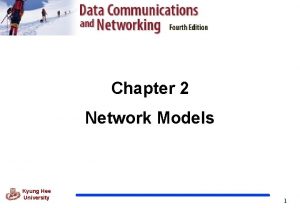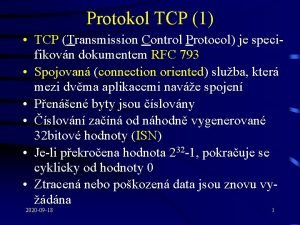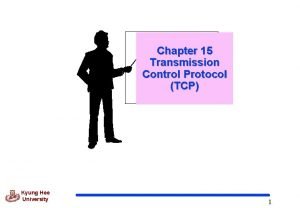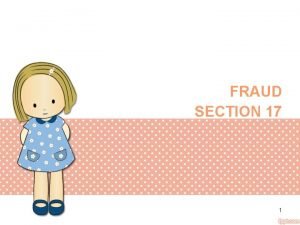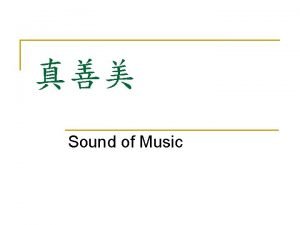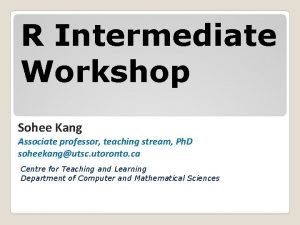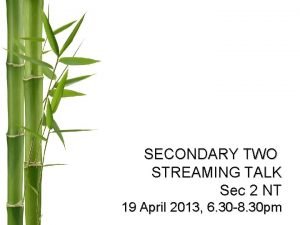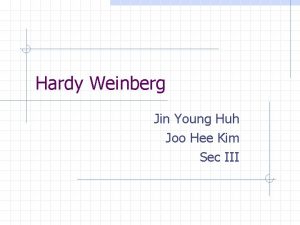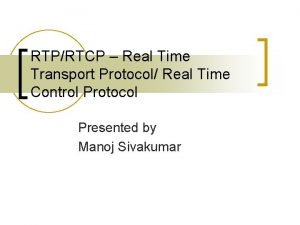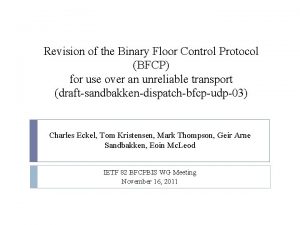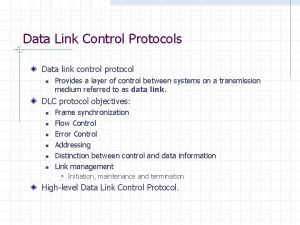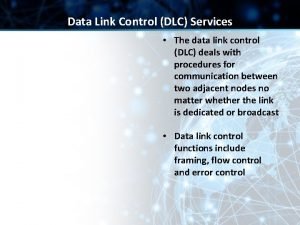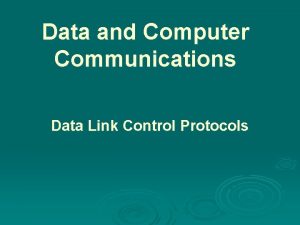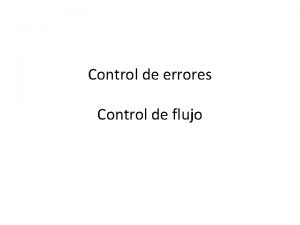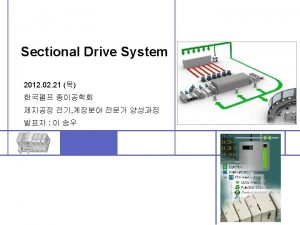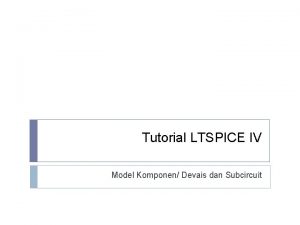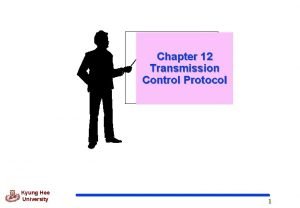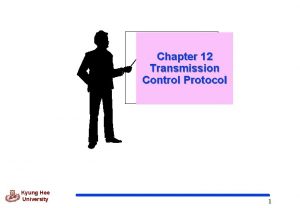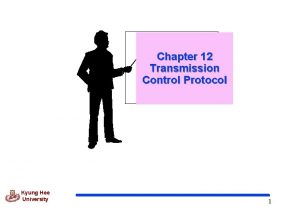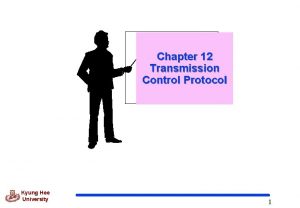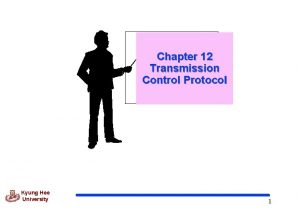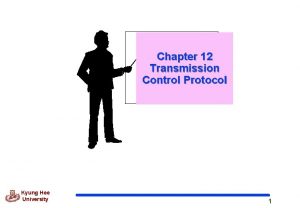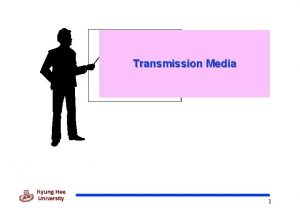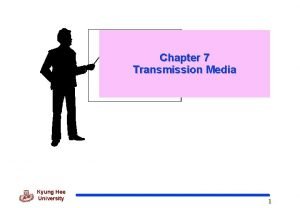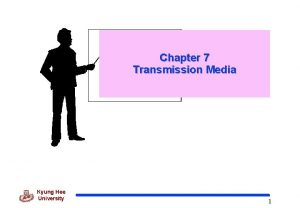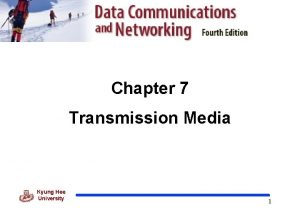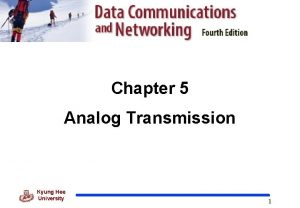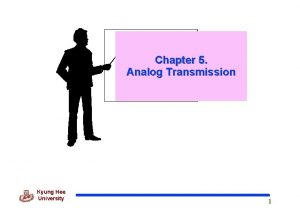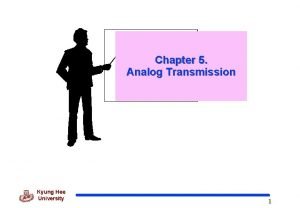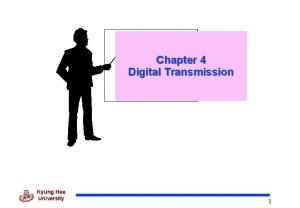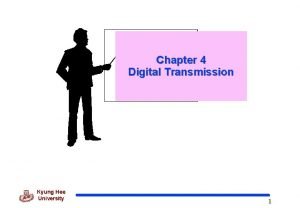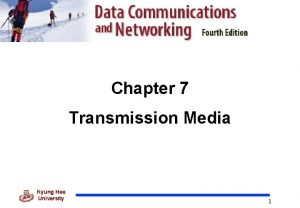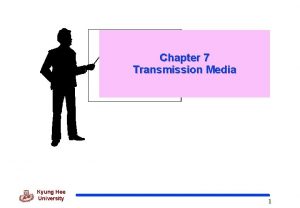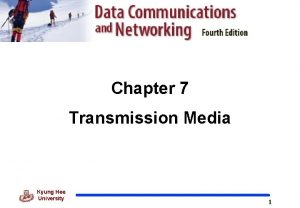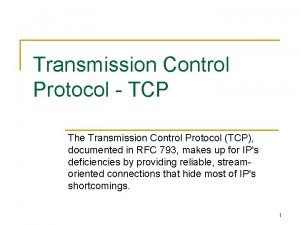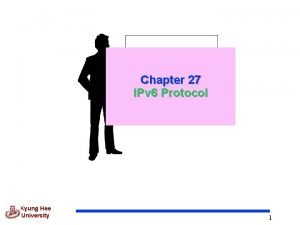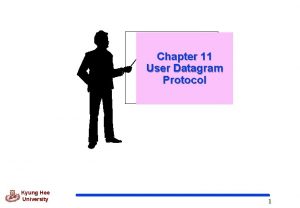Chapter 12 Transmission Control Protocol Kyung Hee University
























































- Slides: 56

Chapter 12 Transmission Control Protocol Kyung Hee University 1

Introduction q Position of TCP Kyung Hee University 2

Introduction (cont’d) q. Responsibilities of Transport Layer to create a process-to-process communication l using port numbers in case of TCP to provide a flow-and-error control mechanism at the transport level l l TCP uses sliding window protocol to achieve error control. TCP uses the acknowledgment packet, time-out, and retransmission to achieve error control. to provide a connection mechanism for the application program l l Kyung Hee University sending streams of data to the transport layer by application program making a connection with the receiver, chopping the stream into transportable units, numbering them and sending them one by one 3

Introduction (cont’d) l l At the receiving end, waiting until all the different units belonging to same application program have received, checking, passing those that are error free and delivering them to the receiving application program as a stream. After the entire stream has been sent, the transport layer should close the connection. q TCP is called a connection-oriented, reliable transport protocol adding connection-oriented and reliability features to the services of IP Kyung Hee University 4

12. 1 Process-to-Process Communication q Host-to-host communication and process-to-process communication Kyung Hee University 5

Process-to-Process Communication (cont’d) q Port Addresses (Numbers) process-to-process communication that achieved through the client/server paradigm to define the client and server programs, we need second identifiers called port numbers. integers between 0 and 65, 535 The client program running on the local computer defines itself with a port number, chosen randomly by the TCP software running on the local host l using a ephemeral port number But, the server program on the remote computer must also define itself with a port number l Kyung Hee University using a well-known port number 6

Process-to-Process Communication (cont’d) q Explanation of port numbers using TENET application Kyung Hee University 7

Process-to-Process Communication (cont’d) q Well-known ports used by TCP Kyung Hee University 8

Process-to-Process Communication (cont’d) q Socket Addresses To make a connection, l l Kyung Hee University needs 2 identifier : IP address + Port number Socket address a pair of socket address – Client socket address – Server socket address 9

12. 2 TCP Services q Stream Delivery Service TCP is a stream-oriented protocol TCP creates an environment in which the two processes seem to be connected by an imaginary “tube” that carries their data across the Internet. Kyung Hee University 10

TCP Services (cont’d) q Sending and Receiving Buffers Because the sending and receiving processes may not produce and consume data at the same speed, TCP needs buffers for storage. One way to implement is to use a circular array Not acknowledged Kyung Hee University 11

TCP Services (cont’d) q TCP Segments Kyung Hee University 12

TCP Services (cont’d) q Stream Data Service (stream transport layer service) The sending TCP 1) accepts a stream of characters from sending application program 2) creates packets called segments, of appropriate size extracted from the stream 3) sends segments across the network The receiving TCP 1) receives segments, extracts data from segments 2) orders segments if they have arrived out of order 3) delivers segments as a stream of characters to the receiving application program Kyung Hee University 13

TCP Services (cont’d) q For stream delivery, the sending and receiving TCPs use buffers l the sending TCP uses sending buffer to store the data coming from the sending application program. – l the receiving TCP receives the segments and stores them in a receiving buffer – – Kyung Hee University the sending application program writes data to the buffer of the sending TCP the receiving application program uses the read operation to read the data from the receiving buffer. Since the rate of reading can be slower than the rate of receiving, the data is kept in the buffer until the receiving application reads it completely. 14

TCP Services (cont’d) q Full-Duplex Service TCP offers full-duplex service l After two application programs are connected to each other, they can both send and receive data. Piggybacking l Kyung Hee University When a packet is going from A to B, it can also carry an acknowledgment of the packets received from B 15

TCP Services (cont’d) q Connection-Oriented Services 1. A’s TCP informs B’s TCP and gets approval from B’s TCP 2. A’s TCP and B’s TCP exchange data in both directions 3. After both processes have no data left to send and the buffers are empty, two TCPs destroy their buffers q Reliable Service TCP uses the acknowledgment mechanism to check the safe and sound arrival of data Kyung Hee University 16

12. 3 TCP Features q. Byte numbers All data bytes being transferred in each connection are numbered by TCP. The numbering starts with a randomly generated number. Number range for first byte : 0 ~ 2 32 -1 l If random number is 1, 057 and total number 6, 000 bytes, the bytes are numbered from 1, 057 to 7, 056 Byte numbering is used for flow and error control. Kyung Hee University 17

Numbering Bytes (cont’d) q Sequence number After the bytes have been numbered, TCP assigns a sequence number to each segment that is being sent. Segment number for each segment is number of the first byte carried in that segment. Kyung Hee University 18

Numbering Bytes (cont’d) q. Example 2 Imagine a TCP connection is transferring a file of 5000 bytes. The first byte is numbered 10001. What are the sequence numbers for each segment if data is sent in five segments with the each segment carrying 1, 000 bytes? Kyung Hee University 19

Numbering Bytes (cont’d) Solution The following shows the sequence number for each segment: Segment 1 10, 001 Segment 2 11, 001 (10, 001 to 11, 001) (11, 001 to 12, 001) Segment 3 12, 001 Segment 4 13, 001 (13, 001 to 14, 001) Segment 5 14, 001 Kyung Hee University (12, 001 to 13, 001) (14, 001 to 15, 001) 20

Numbering Bytes (cont’d) q Acknowledgment Number The value of the acknowledgment field in a segment defines the number of the next byte a party expects to receives. The acknowledgment number is cumulative. Kyung Hee University 21

12. 3 Segment q A packet in TCP is called segment Kyung Hee University 22

Segment (cont’d) q Source port address defining the port number of application program in the host that is sending the segment q Destination port address defining the port number of application program in the host that is receiving the segment q Sequence number defining the number assigned to the first byte of data contained in this segment during the connection establishment, each party uses a random number generator to create an initial sequence number (ISN) Kyung Hee University 23

Segment (cont’d) q Acknowledgment number If the source of the segment has successfully received byte number x from the other party, it defines x+1 as the acknowledgment number q Header length Indicating the number of 4 -byte words in the TCP header l the value between 5 and 15 (20 and 60 bytes) q Reserved For future use Kyung Hee University 24

Segment (cont’d) q Control Enabling flow control, connection establishment and termination, and mode of data transfer in TCP Kyung Hee University 25

Segment (cont’d) q Description of flags in the control field Kyung Hee University 26

Segment (cont’d) q Window size defining the size of the window, in bytes, that the other party must maintain. maximum size of window : 65, 535 bytes q Checksum : picture in next page q Urgent pointer used when the segment contains urgent data defining the number that must be added to the sequence number to obtain the number of the last urgent byte in the data section of the segment q Options : 40 bytes Kyung Hee University 27

Segment (cont’d) Kyung Hee University 28

Segment (cont’d) q A TCP segments is encapsulated in an IP datagram Kyung Hee University 29

12. 4 TCP Connection q The server program tells its TCP to make a passive open q The Client program issues a request for an active open. Kyung Hee University 30

TCP Connection – three-way handshaking q A SYN segment cannot carry data, but it consumes one sequence number. q A SYN + ACK segment cannot carry data, but does consume one sequence number. q An ACK segment, if carrying no data, consumes no sequence number. Kyung Hee University 31

TCP Connection (Cont’d) q Data transfer Kyung Hee University 32

TCP Connection (Cont’d) q Urgent data To send urgent data Use of URG bit set by sending TCP Receiving TCP extracts the urgent data from the segment using urgent pointer Kyung Hee University 33

TCP Connection (Cont’d) q Connection Termination The FIN segment consumes one sequence number if it does not carry data. The FIN + ACK segment consumes one sequence number if it does not carry data. Kyung Hee University 34

TCP Connection (Cont’d) q Half-close Kyung Hee University 35

12. 5 State Transition Diagram q To keep track of all the different events happening during connection establishment, connection termination, and data transfer, the TCP software is implemented as a finite state machine. Kyung Hee University 36

State Transition Diagram (cont’d) Kyung Hee University 37

Kyung Hee University 38

State Transition Diagram (Cont’d) q A state transition diagram Server Client Unusual Input / Output Kyung Hee University Now connection is closed in one direction. 39

Connection Establishment and Termination Kyung Hee University 40

Connection Termination Using Three-way Handshake Kyung Hee University 41

Simultaneous Open Kyung Hee University 42

Simultaneous Close Kyung Hee University 43

Denying a Connection Kyung Hee University 44

Aborting a Connection Kyung Hee University 45

12. 4 Flow Control q Defining the amount of data that a source can send before receiving an acknowledgement from the destination. q Sliding window For flow control, TCP uses a sliding window protocol The window covers a portion of the buffer that a host can send before worrying about an acknowledgment from other host A sliding window is used to make transmission more efficient as well as to control the flow of data so that the destination does not become overwhelmed with data. TCP sliding windows are byte oriented. Kyung Hee University 46

Sliding Window Protocol Kyung Hee University 47

Sliding Window Protocol q an Example Kyung Hee University 48

Flow Control (cont’d) q In TCP, the sender window size is totally controlled by the receiver window value. However, the actual window size can be smaller if there is congestion in the network. q Some Points about TCP’s Sliding Windows: 1. The source does not have to send a full window’s worth of data. 2. The size of the window can be increased or decreased by the destination. 3. The destination can send an acknowledgment at any time. Kyung Hee University 49

12. 6 Error Control q Including mechanisms for detecting corrupted segments, lost segments, out-of-order segments, and duplicated segments. q Also, including a mechanism for correcting errors after they are detected. q Error Detection and Correction Checksum Acknowledgment : TCP does not use negative acknowledgment Time-out Kyung Hee University 50

TCP Sliding Windows q Some points about TCP’s sliding windows: q ❏ The size of the window is the lesser of rwnd and cwnd. ❏ The source does not have to send a full window’s worth of data. ❏ The window can be opened or closed by the receiver, but should not be shrunk. ❏ The destination can send an acknowledgment at any time as long as it does not result in a shrinking window. ❏ The receiver can temporarily shut down the window; the sender, however, can always send a segment of one byte after the window is shut down. Kyung Hee University 51

Normal Operation Kyung Hee University 52

Lost Segment Kyung Hee University 53

Fast Retransmission Kyung Hee University 54

Lost Ack Kyung Hee University 55

Lost ACK Corrected by Resending a Segment Kyung Hee University 56
 Kyung hee university mba
Kyung hee university mba Kyung hee university hospital at gangdong
Kyung hee university hospital at gangdong Html q
Html q Kyung hee model
Kyung hee model Transmission control protocol
Transmission control protocol Tcp (transmission control protocol) to protokół
Tcp (transmission control protocol) to protokół Transmission control protocol
Transmission control protocol Captain kyung
Captain kyung Transmission control block
Transmission control block Out of programme pause
Out of programme pause Tan hee juan case
Tan hee juan case Horus eportfolio
Horus eportfolio Horus eportfolio
Horus eportfolio Lau hee teah v hargill engineering sdn bhd
Lau hee teah v hargill engineering sdn bhd Choi dae hee
Choi dae hee Kim yeon hee
Kim yeon hee Hee chang trading co ltd
Hee chang trading co ltd Tan hee juan case
Tan hee juan case Hee joo lee
Hee joo lee Yodelay hee hoo sound of music
Yodelay hee hoo sound of music So-hee kang utsc
So-hee kang utsc Aaou
Aaou Horus hee
Horus hee Seet tiat hee
Seet tiat hee Joo hee jin
Joo hee jin Skinny protocol
Skinny protocol Real time control protocol
Real time control protocol Domain host control protocol
Domain host control protocol High level data link control
High level data link control Bfcp sip
Bfcp sip Real time control protocol
Real time control protocol The ppp link control protocol was terminated
The ppp link control protocol was terminated Hdlc osi layer
Hdlc osi layer Flow control protocols
Flow control protocols Dlc protocol
Dlc protocol Data link control protocol
Data link control protocol Chapter 19 disease transmission and infection prevention
Chapter 19 disease transmission and infection prevention Chapter 19 disease transmission and infection prevention
Chapter 19 disease transmission and infection prevention Chapter 15:5 sterilizing with an autoclave
Chapter 15:5 sterilizing with an autoclave Chapter 19 disease transmission and infection prevention
Chapter 19 disease transmission and infection prevention 沈榮麟
沈榮麟 Primary control vs secondary control
Primary control vs secondary control Product inspection vs process control
Product inspection vs process control Fluids mechanics
Fluids mechanics Stock control e flow control
Stock control e flow control Control volume vs control surface
Control volume vs control surface Negative control definition
Negative control definition What is negative control
What is negative control Hdlc adalah
Hdlc adalah Control de flujo y control de errores
Control de flujo y control de errores Negative control vs positive control examples
Negative control vs positive control examples Control flow error
Control flow error Scalar control vs vector control
Scalar control vs vector control Control c control v
Control c control v Air ionization in wireless power transmission
Air ionization in wireless power transmission Wireless power transmission project report doc
Wireless power transmission project report doc Transmission model
Transmission model



